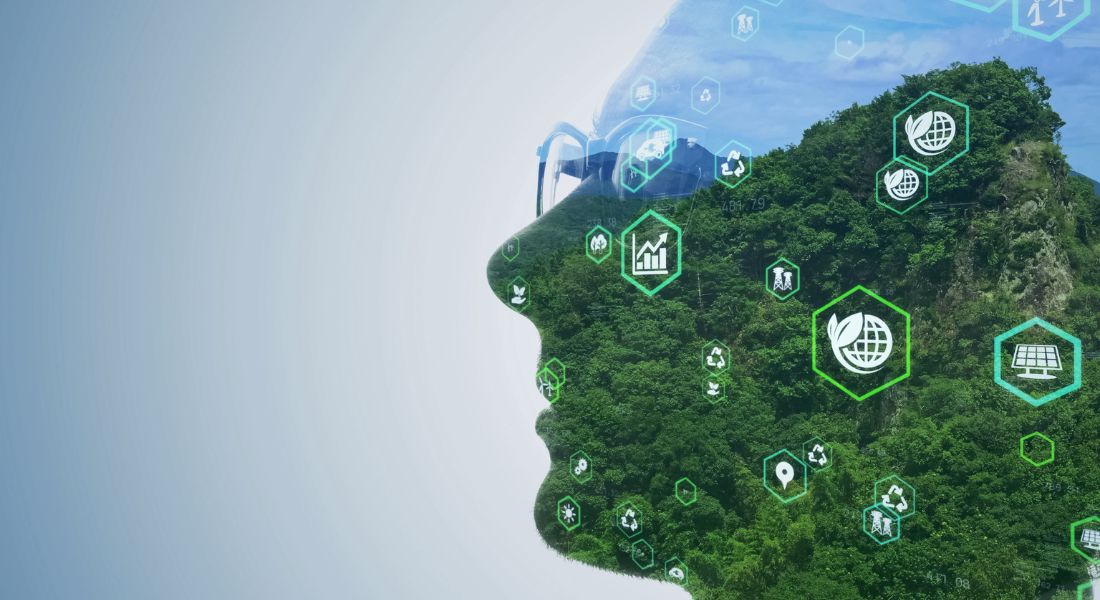We are witnessing a remarkable fusion of technology and creativity in 2024
One where web designers are not only embracing cutting-edge advancements but are also redefining the very essence of user interaction and aesthetic appeal.
From AI-driven interfaces to the resurgence of tactile, emotion-evoking elements. The trends of 2024 are shaping a future where web design goes beyond functionality to becoming a profound expression of technological prowess and artistic vision.
We delve into the key trends that are becoming evident. Offering insights into how they are transforming the user experience and setting new benchmarks for innovation in web design
1. Sustainability in Web Design
Sustainability in web design encompasses various strategies aimed at reducing the environmental impact of digital products, such as websites and applications.
As the internet grows, so does its carbon footprint, with data centres, web hosting, and the devices used to access websites all consuming significant amounts of energy. Here are some key aspects you might consider including in your article on this topic:
Optimised Performance and Energy Efficiency
- Efficient Coding Practices - Cleaner, more efficient code can reduce processing power requirements, which in turn minimises energy consumption. This includes simplifying code, removing unnecessary scripts and files, and optimising images and other media.
- Reducing Data Transfer - Minimise data transfer by compressing files, using caching effectively, and choosing the right file formats and sizes for media. These practices not only speed up website performance but also reduce the energy required to transmit data across the web.
Green Hosting
- Eco-friendly Web Hosting - Green web hosting providers use renewable energy sources or carbon offsetting to minimise the environmental impact of their data centres. Choosing a green host can be a straightforward step for web designers and website owners to reduce their digital carbon footprint.
- Energy-efficient Data Centres - Advancements in data centre technology that reduce energy consumption, such as improved cooling techniques, energy-efficient hardware, and better server management.
Sustainable UX Practices
- User Experience Design for Sustainability - UX design can contribute to sustainability. For example, designing interfaces that encourage or default to energy-saving modes, or that promote sustainable behaviours (like encouraging digital rather than physical transactions where appropriate).
- Dark Mode - Features like dark mode not only reduce screen energy consumption on OLED and LED screens but also offer an aesthetic choice that can reduce eye strain and extend device battery life.
Lifecycle Thinking
- Designing for Longevity - Designing websites that are timeless rather than trendy, reducing the need for frequent redesigns and updates, which consume resources.
- Maintenance and Updates - Maintain websites efficiently! Regular updates and optimisations can prolong a website's life, make it more secure, and ensure it runs efficiently, thus being less taxing on resources.
Carbon Awareness and Tracking
- Carbon Calculators for Websites - Introduce tools that can estimate the carbon emissions of websites based on factors like page size, server location, and traffic. This can help designers make informed decisions about how to reduce their site’s impact.
- Ongoing Monitoring - Advocate for regular monitoring and auditing of website efficiency and carbon output as a standard practice for sustainable web design.
Sustainability in web design can contribute positively to the environment. By implementing sustainable practices we align with broader environmental goals.
2. Advanced AI and Automation in Web Design
AI and automation are revolutionising web design by streamlining workflows, personalising user experiences, and offering new capabilities that were previously impossible or cost-prohibitive. Here are some key areas where AI and automation are making significant impacts:
AI-Driven Design Tools
- Automated Design Assistance - Tools like Adobe’s Sensei use AI to automate routine design tasks, such as cropping images, optimising colours, and even suggesting design layouts based on content. This allows designers to focus more on creative aspects and less on repetitive tasks.
- AI Prototyping - AI is also being used to rapidly prototype websites. By inputting design preferences and content, AI can generate website layouts that are both aesthetically pleasing and optimised for user engagement.
Personalisation Through AI
- Dynamic Content Delivery - AI algorithms analyse user behaviour, demographic data, and engagement metrics to deliver personalised content and design experiences tailored to individual user needs. This could mean dynamic changes to a website’s layout, content, or functionality based on the user’s past interactions or real-time actions.
- Predictive User Interfaces - AI can predict user actions and streamline the user interface to facilitate these actions, enhancing user experience and engagement. For example, a predictive search feature could anticipate user queries and offer results faster.
AI for Accessibility
- Enhancing Accessibility - AI is being used to automatically adjust websites for accessibility concerns, such as modifying colour contrasts for better visibility or providing real-time text to speech for users with visual impairments.
- Accessibility Testing - AI tools can scan websites to detect and suggest fixes for accessibility issues, ensuring that web designs meet compliance standards and are usable by people with various disabilities.
Voice User Interface (VUI)
- Integration of Voice Commands - As voice interaction becomes more prevalent, websites are increasingly incorporating voice user interfaces. AI is central to interpreting natural language, allowing users to interact with websites through voice commands.
- Voice Search Optimisation - Websites are also being optimised for voice search, which involves understanding and implementing SEO strategies that cater to voice queries.
AI and User Experience Testing
- Automated User Testing - AI can simulate user journeys and report on user experience, providing insights more quickly and at a larger scale than traditional user testing.
- Heatmaps and Behavioural Predictions - AI tools generate heatmaps and predict user behaviour, allowing designers to optimise web pages based on where users are most likely to focus their attention.
Ethical Considerations and Trust
- Bias and Privacy - Increasing the use of AI in web design, ethical concerns such as data privacy and bias in AI algorithms become critical topics. It’s important if you use AI to use it responsibly. Ensuring that personal data is handled securely and that AI systems are as unbiased as possible.
- Transparency in AI Use - If you use AI Inform users how AI is being used on websites they visit. Particularly regarding how their data is being used to personalise their experiences.
As we move into 2024, these technologies continue to shape how websites are designed, operated, and experienced, making them integral topics for any forward-looking discussion on web design trends. However not everyone is jumping keenly down the rabbit hole.

3. Inclusivity and Accessibility in Web Design
In 2024, web design trends continue to emphasise inclusivity and accessibility, ensuring that websites are usable and welcoming to all users, regardless of their abilities. This trend is not just about adhering to legal requirements but also about embracing a broader audience, enhancing user experience, and fostering positive brand perceptions.
Designing for Accessibility
- Accessibility by Design - This approach integrates accessibility considerations into the design process from the outset, rather than treating them as an afterthought. It involves understanding the Web Content Accessibility Guidelines (WCAG) and ensuring that websites meet at least AA standards, if not AAA.
- Technological Enhancements - Use of AI and automation to identify and fix accessibility issues in real time. Like adjusting colour contrasts automatically or providing alternative text for images as they upload.
Broadening the Scope of Inclusivity
- Cultural Sensitivity - Designers are increasingly mindful of the cultural context of their audience, incorporating language options, culturally relevant content, and design elements that resonate with diverse user groups.
- Consideration for Neurodiversity - Websites are adapting to be more inclusive of neurodiverse users by offering flexible navigation options, choices in how information is presented (such as allowing users to switch between text and video), and avoiding design elements that can cause sensory overload.
Inclusive User Personas
- Diverse Personas in User Testing - Inclusion of a diverse range of user personas in the design testing phase. Different ages, disabilities, and cultural backgrounds. This ensures the design is tested across a range of potential users to better cater to a wide audience.
- Empathy in Design - Encouraging designers to engage directly with users from various demographics to understand their experiences and challenges, which can be invaluable in crafting solutions that genuinely address user needs.
Universal Design Principles
- Seven Principles of Universal Design:These include
- equitable use,
- flexibility in use,
- simple and intuitive use,
- perceptible information,
- tolerance for error,
- low physical effort,
- and size and space for approach and use.
Applying these principles helps create designs that benefit a broader user base.
- Scalable and Adaptive Design: Websites that adapt to different user settings and assistive technologies, ensuring that all users can navigate and interact with content effectively.
Tools and Technologies
- Automated Accessibility Testing Tools: Tools like axe, WAVE, and Lighthouse are being increasingly used to help developers identify and correct accessibility issues.
- Assistive Technologies: Better integration with technologies such as screen readers, speech recognition software, and alternative input devices to ensure seamless user experiences.
Ethical Considerations
- Ethical Design: Moving beyond compliance, there is a growing recognition of the ethical obligation to design inclusively, with a focus on privacy, security, and respect for user data.
Education and Awareness
- Training for Design Teams: Providing ongoing training for design and development teams on the latest accessibility guidelines and inclusive design practices.
- Community Engagement: Actively engaging with communities, particularly those with disabilities, to gather feedback and continuously improve design approaches.
Inclusivity and accessibility are not just about enabling access but about designing experiences that are meaningful and empowering for all users. As web design trends in 2024 continue to evolve, these principles play a pivotal role in shaping digital spaces that are not only functional but also equitable and welcoming.
4. Visually Rich Experiences in Web Design
Visually rich experiences combine aesthetics with functionality, pushing the boundaries of traditional design to create immersive and interactive environments. Here’s how this trend is manifesting in web design:
Microinteractions
- Definition and Importance - Microinteractions are subtle effects and animations that occur in response to a user's actions. They provide immediate feedback to the user about their interactions and can enhance the usability and enjoyability of digital interfaces.
Examples - This can include animations that confirm a form submission, interactive hover states on buttons, or visual effects that animate loading processes.
Advanced Animations
- Purposeful Animations - Beyond mere decoration, advanced animations are used to guide users through a site, draw attention to important information, and enhance storytelling. These animations make the user journey intuitive and engaging.
- Technologies - CSS animations, JavaScript frameworks like GSAP (GreenSock Animation Platform), and SVG animations are commonly used to create complex, high-performance animations without impacting the site’s performance.
Cinematic Experiences
- Full-Screen Video and Dynamic Backgrounds - Using full-screen video backgrounds or dynamic graphical backgrounds can immediately capture user interest and convey a mood or brand identity.
- Integration with Layout - Videos and large images are integrated into the site design in ways that don't detract from usability but enhance the narrative and emotional impact of the content.
Storytelling Through Design
- Visual Storytelling - Websites are increasingly using visual sequences to tell stories. This can be achieved through scrolling animations that narrate a story as the user moves down the page.
- Interactive Storytelling - Interactive elements are added to let users choose their path or explore content in a non-linear fashion, which can increase engagement and time spent on the site.
Rich User Interfaces
- Depth and Shadows - Use of shadows, layers, and motion can create a sense of depth that makes user interfaces feel more tactile and real.
- Material Design and Neumorphism - These design languages use gradients, shadows, and highlights to simulate physicality in digital interfaces, making them intuitive and engaging.
Personalisation of Visuals
- Adaptive Visuals - Design elements that adapt based on the user's behaviour, time of day, location, or other personal data to make the visual experience feel more customized and relevant.
- Context-Aware Imagery - Images and graphics that change based on the context of user interactions or past user behaviour.
Augmented Reality (AR)
- Web-based AR - Integration of AR into web platforms without the need for additional applications. This allows users to see products or features in their own environment directly through their web browser.
- Enhanced Shopping Experiences - For e-commerce, AR can help users visualize products more realistically, improving confidence in purchase decisions.
Parallax Effects
- Enhanced Depth Perception - Parallax scrolling, where background elements move at a different speed than foreground elements during scrolling, can create a sense of depth and dynamism.
- Use in Storytelling - Parallax effects can also be used to subtly reveal elements of a story or product features as a user scrolls, making the exploration more engaging.
As we move further into 2024, the push towards more integrated and immersive visual experiences in web design is likely to increase, leveraging new technologies and creative design approaches.

5. Minimalism and Maximalism
Both minimalism and maximalism have distinct places in web design, serving different aesthetic and functional purposes. In 2024, designers are finding innovative ways to blend these styles to create unique user experiences that cater to varying user preferences and business goals.
Core Features of Minimalism
- Simplicity and Clarity: Minimalist design focuses on simplicity and the 'less is more' philosophy. The aim is to create clarity and remove all superfluous elements, which helps enhance user experience by making navigation and comprehension easier.
- Functional Aesthetics: Every element in a minimalist design serves a purpose. Unnecessary decorations are avoided, and the emphasis is on functionality, which often results in a highly clean and sharp interface.
- Use of Negative Space: Ample whitespace is a hallmark of minimalism. It helps in drawing attention to the content and elements that truly matter, reducing cognitive load and focusing user attention effectively.
Core Features of Maximalism
- Richness and Exuberance: Maximalism in web design is characterised by richness in colours, patterns, and textures. It's a celebration of abundance and saturation, often seen in bold colour schemes, intricate patterns, and detailed backgrounds.
- Emotional Engagement: Maximalist designs often aim to evoke stronger emotional responses by creating visually compelling and striking experiences. These designs can be memorable and may stand out in a saturated market.
- Layering and Depth: Unlike minimalism, maximalism embraces complexity and depth, with layered design elements that create a dense visual experience.
Balancing Minimalism and Maximalism
- Contextual Usage: The choice between minimalism and maximalism often depends on the brand's identity and the intended audience. For instance, luxury brands may opt for maximalism to convey opulence, while tech companies might prefer minimalism to highlight usability and innovation.
- Combining Elements: Some designers are finding ways to integrate elements of both styles in a single design. For example, a minimalist homepage might lead to more richly designed sub-pages as the user goes deeper into the site, or vice versa.
- Transitional Designs: Implementing transitional designs where elements morph from minimal to maximal as the user interacts with the page can create dynamic experiences that keep the user engaged.
Functional Minimalism
- Performance and SEO: Minimalist designs are not just aesthetically pleasing but also practical. They tend to load faster and perform better in terms of SEO due to their streamlined nature. This practicality can significantly enhance the site's visibility and user retention.
- Adaptive Changes: Even within minimalism, there is a trend towards making designs slightly more elaborate without overwhelming the user. This might include subtle animations or a touch of color to guide the user's journey.
Exploring New Dimensions
- Interactive Storytelling: Both styles can be leveraged for storytelling. Minimalism can guide users through a story with clean cuts and clear paths, whereas maximalism might immerse them in a vibrant narrative with visually rich storytelling techniques.
As we move through 2024, the trend in web design shows that neither minimalism nor maximalism is seen as superior in all contexts but that the choice depends on the message the brand wants to convey and the preferences of the target audience. This nuanced approach allows for more creative freedom and the ability to tailor designs more precisely to user needs and brand goals.






